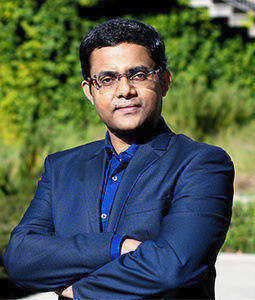Bringing Scalable Millimeter-Wave Networks and Applications to the Masses
Bringing Scalable Millimeter-Wave Networks and Applications to the Masses
Internet-of-Things (IoT) systems play an integral role in our daily lives, and we are currently witnessing an explosion of the IoT ecosystem, which includes not only smartphones but also smart, ubiquitous objects embedded with communication, computation, and sensing capabilities. Emerging IoT systems, such as autonomous vehicles, immersive virtual and augmented reality, tactile internet, holoportation, and smart, connected buildings, promise to automate human lives at unprecedented levels this decade. However, such systems rely on two critical foundations: (1) Next-generation wireless network architectures that can serve billions of devices; and (2) Ubiquitous sensing techniques that enable the objects to be "truly smart" by understanding and interpreting the ambient conditions and micro-activities with high precision.
My research team has been building these two foundations. We design, develop, and deploy experimental data-driven computational and deep learning models to extract intelligence from wireless signals, which, in turn, enable ubiquitous sensing modalities and high-resilience and high-performance networks. In this talk, I will go through some of the design and prototyping of our current works that use extremely high-frequency millimeter-wave wireless to enable wire-like connectivity and reliability, and applications in healthcare and beyond-visions.
Date and Time
Location
Hosts
Registration
-
 Add Event to Calendar
Add Event to Calendar
Loading virtual attendance info...
Speakers
 Professor Sanjib Sur
Professor Sanjib Sur
Bringing Scalable Millimeter-Wave Networks and Applications to the Masses
Internet-of-Things (IoT) systems play an integral role in our daily lives, and we are currently witnessing an explosion of the IoT ecosystem, which includes not only smartphones but also smart, ubiquitous objects embedded with communication, computation, and sensing capabilities. Emerging IoT systems, such as autonomous vehicles, immersive virtual and augmented reality, tactile internet, holoportation, and smart, connected buildings, promise to automate human lives at unprecedented levels this decade. However, such systems rely on two critical foundations: (1) Next-generation wireless network architectures that can serve billions of devices; and (2) Ubiquitous sensing techniques that enable the objects to be "truly smart" by understanding and interpreting the ambient conditions and micro-activities with high precision.
My research team has been building these two foundations. We design, develop, and deploy experimental data-driven computational and deep learning models to extract intelligence from wireless signals, which, in turn, enable ubiquitous sensing modalities and high-resilience and high-performance networks. In this talk, I will go through some of the design and prototyping of our current works that use extremely high-frequency millimeter-wave wireless to enable wire-like connectivity and reliability, and applications in healthcare and beyond-visions.
Biography:
Sanjib Sur is an Assistant Professor in the Department of Computer Science and Engineering at the University of South Carolina, Columbia. He received his Ph.D. from the University of Wisconsin - Madison. His research interest lies in wireless systems and ubiquitous computing, and his research work has been regularly published in top conferences in these areas, especially ACM MobiCom, MobiSys, SIGMETRICS, USENIX NSDI, and IEEE INFOCOM. He is the recipient of ACM HotMobile Best Poster and Best Poster Runner-Up Awards in 2021 and President of India Gold Medal in 2012. Sanjib holds 8 US Patents with 8 more pending. He served as the TPC co-chair for IEEE STEERS 2021-2020 and ACM mmNets 2020.

